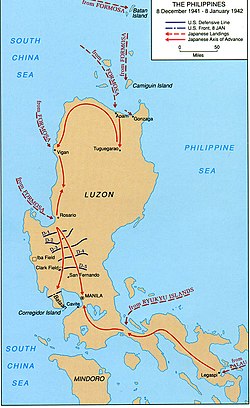Japanese invasion of Legazpi
| Japanese invasion of Legazpi | |||||||
|---|---|---|---|---|---|---|---|
| Part of Philippines campaign (1941–1942), Pacific War | |||||||
 A map of Luzon Island showing Japanese landings and advances from 8 December 1941 to 8 January 1942 | |||||||
| |||||||
| Belligerents | |||||||
|
| |||||||
The Japanese Invasion of Legazpi (Filipino: Paglusob ng mga Hapones sa Legazpi) on 12 December 1941 was one in a series of advance landings made by Imperial Japanese forces as first step in their invasion of the Philippines. The purpose was to obtain control of local air strips, which could be used as forward bases by fighter aircraft for operations in central Luzon. Control of Legazpi was an important point in the Japanese strategy, as it would also give them control of San Bernardino Strait, between the islands Luzon and Samar, which would prevent the Americans from bringing in reinforcements from the south. The first invasion was at
Disposition of forces
The area of Legazpi was in theory defended by
On the Japanese side,
The invasion force was supported by a large fleet from the Imperial Japanese Navy led by Rear Admiral Kyuji Kubo, consisting of the light cruiser Nagara, the destroyers Yamakaze, Suzukaze, Kawakaze, Umikaze, Yukikaze, Tokitsukaze, the seaplane tenders Mizuho and Chitose, two minesweepers, two patrol vessels and seven transports.[3]
Distant cover was provided by Vice Admiral Ibō Takahashi with the aircraft carrier Ryūjō, heavy cruisers Haguro, Myōkō and Nachi and the destroyer Shiokaze. In addition, the covering fleet was accompanied by Destroyer Squadron 2 with the light cruiser Jintsu and destroyers Amatsukaze, Hayashio, Kuroshio, Hatsukaze, Natsushio, and Oyashio, which was tasked with minelaying operations in San Bernardino Straits.[3]
Landing and aftermath
The Kimura Detachment landed at Legazpi on the morning of 12 December without opposition, as the nearest American forces were over 240 km (150 mi) away. By 09:00 they were in control of both the airfield and the railroad. The following day, the Japanese naval covering force withdrew to Palau.[1]
The Philippine 51st Division sent an engineering battalion south into the Bicol Peninsula to destroy bridges and to prevent railroad equipment from falling into the hands of the Japanese. The first American counterattack was a strafing attack on 12 December by two fighter aircraft of the Far East Air Force on the newly captured airstrip at Legazpi, killing three Japanese. This was followed by an attack by three Boeing B-17 Flying Fortress bombers, which destroyed nine Japanese aircraft on legazpi runway. However, only one of the B-17s made it back to its base at Del Monte Airfield.
Once the city of Legazpi was secure, Kimura sent his forces north on Highway 1 to capture the city of
However, on 23 December, the Japanese made a landing at
Consequences
In retrospect, the advance landings by the Japanese in southern Luzon, including at Legazpi, largely accomplished its strategic objective of encircling the American forces in central Luzon, preventing both escape and reinforcement. Tactically, the air fields seized were small, and with the rapid advance of the Japanese into both central and southern Luzon, were soon unnecessary for further operations.[1]
References
- ^ a b c d e f g "The First Landings". Retrieved 18 March 2014.
- ISBN 978-1849086097.
- ^ ISBN 1299324614.


